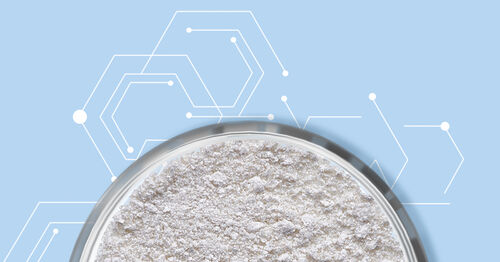
What are ceramides, and what do they do for your skin?

What are ceramides?
Ceramides are waxy lipid molecules that naturally occur within the body. These lipid molecules have many functions within the body and are vital for healthier skin.¹ Ceramides are especially important in the skin: this natural ingredient makes up around 40% of the outermost layer of skin (the stratum corneum). Here, ceramides are critical to maintaining the epidermal barrier function of the skin.
The skin’s ceramide content can change (both in terms of quality and quantity) when we are dehydrated and as we get older. Ceramides are therefore used in skincare products to help the skin stay and look healthy.
If you want to know how to address dry skin, read more on our Dealing with 5 Common Causes of Dry Skin page.

What is a ceramide made from?
Ceramides are made from a sphingosine (a molecule formed by amino acids and carbon) and a fatty acid. There are 15 different types of ceramides and these are produced from combining different variations of these two key components. When reviewing a skincare product’s ingredient label, ceramides could be listed under some of these names:
- Ceramide 1 or ceramide EOS
- Ceramide 2, also known as NS or NG
- Ceramide 3 or NP
- Ceramide 6-II or AP
- Ceramide 9, or ceramide EOP
- Phytosphingosine
- Sphingosine
What's the difference between natural and synthetic ceramides?
Ceramides can be found naturally in the skin and body, or produced synthetically. Both forms have nearly the same quality and beneficial effect: they both support healthier-looking skin.
Although ceramides can be found in some foods (such as rice, wheat and sweet potatoes), you can directly apply ceramides to your skin through a tailored skincare product. For example, Cetaphil’s Soothing Foam wash contains ceramides and also helps the skin’s natural barrier.
What do ceramides do?
One of the most important parts of the skin’s surface architecture is the extracellular lipid matrix of the stratum corneum, which is made from ceramides and other important molecules. The extracellular matrix provides a supportive structure for skin cells and helps bind them together to form a compact and effective skin barrier. Ceramides contribute to the hydrophobic properties (repels water) of the matrix.
As ceramide levels and composition can be affected by the aging process, this can affect the skin barrier. To ensure the skin barrier remains strong, you can replenish your skin’s ceramide levels through ceramide boosting and ceramide containing toners, serums and moisturizers. Boosting and supplementing the skin’s natural ceramide levels with products like our Restoraderm Skin restoring body moisturiser with Ceramides, allows the skin to retain moisture for longer. These types of products will also help the skin to appear healthier, softer and smoother. and smoother.

Ceramides benefits for skin
- Restores the skin barrier: Applying skincare products containing ceramides could help to restore the skin’s ceramide level and support the skin barrier.²
- Hydrates and locks in moisture: By boosting the hydrophobic features of the extracellular matrix, ceramides are able to prevent moisture loss from the epidermis and keep moisture locked in.
- Soothes: As ceramides help to lock moisture into the skin, skincare products containing ceramides can be used to address dryness; this may soothe sensitive flaky skin. If you need to soothe your skin, try our Restoraderm Lotion with Ceramides.
How can I use ceramides in a skincare routine?
Ceramides can be found in many skincare products and can be used in different roles within your skincare routine. However, it is also important to consider using other ingredients in your routine to help address your skin’s unique needs.
For example, products containing glycerin will have humectant features i.e. they can draw moisture into the skin. These types of products work well with ceramide-containing products: glycerin draws moisture into the skin, and ceramides can help that moisture to remain locked in. If you have concerns about skin dryness related to eczema, try our Cetaphil Restoraderm Moisturizer. This product contains ceramides, glycerin and colloidal oatmeal which can help to soothe dry and itchy skin.
Another ingredient you may want to look for in your products is niacinamide Niacinamide (vitamin B3). Niacinamide can help tackle the appearance of fine lines and wrinkles, as well as helping with skin tone and texture. To access these benefits, try our Restoring Lotion which contains niacinamide and can be used to address the appearance of aging skin. For younger skin, you can use our Restoraderm body Lotion which contains both niacinamide and ceramides.
To learn more about ingredients which could help your skin type, visit our ingredients page.
The bottom line
Using ceramides for skin care can help to support the skin barrier, while also soothing the skin and allowing moisture to stay locked in for longer. Although ceramides are found naturally within the skin, they can be affected in certain skin conditions or with time get depleted over time and this can reduce the effectiveness of the skin’s barrier function. Incorporating ceramides into your skincare routine, in combination with other skincare ingredients, can help you achieve healthier looking skin.
- Wattenberg, B. (2018) "The long and the short of ceramides", Journal of Biological Chemistry, 293(25), pp. 9922-9923. doi: 10.1074/jbc.h118.003522.
- Meckfessel, M. and Brandt, S. (2014) "The structure, function, and importance of ceramides in skin and their use as therapeutic agents in skin-care products", Journal of the American Academy of Dermatology, 71(1), pp. 177-184. doi: 10.1016/j.jaad.2014.01.891.













.jpg?sw=450&sh=450&sm=fit&q=85)




